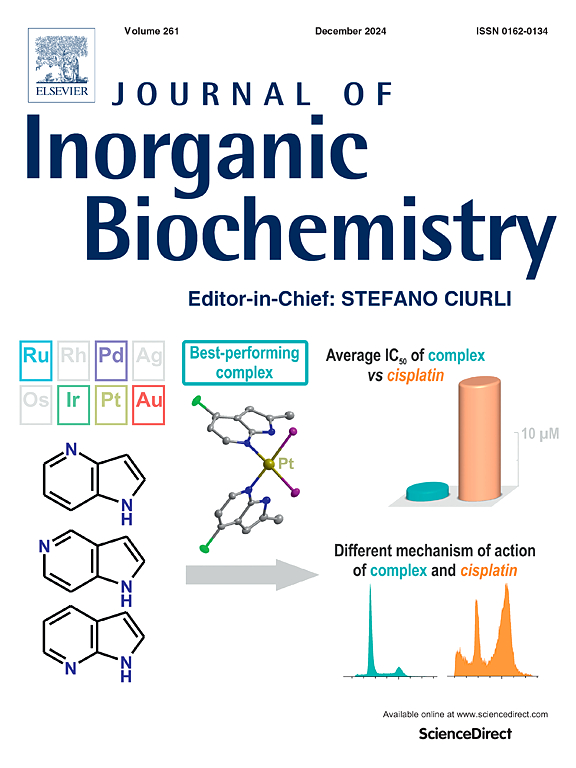Broadening the chemical diversity of oxidovanadium(V) complexes for targeting neglected tropical diseases
IF 3.8
2区 化学
Q2 BIOCHEMISTRY & MOLECULAR BIOLOGY
引用次数: 0
Abstract
Chagas disease and Leishmaniasis, caused by Trypanosoma cruzi and Leishmania spp., respectively, are highly prevalent neglected tropical diseases (NTDs) that pose significant global health challenges. In our pursuit of effective vanadium-based therapeutics against these diseases, we previously developed several series of oxidovanadium(V) complexes featuring bidentate bioactive ligands and Schiff base tridentate ligands. The current study extends our previous research by incorporating in the same molecule, a tridentate bromo-substituted isonicotinyl hydrazone Schiff base ligand, BrIS, and a 8-hydroxyquinoline derivative (L), leading to the synthesis and comprehensive characterization of five new complexes, [VVO(BrIS-2H)(L-H)]. Most of new complexes exhibited activity in the micromolar range against the infective trypomastigote form of T. cruzi (EC50, 24h: 0.73–7.95 μM) and against L. infantum promastigotes (IC50, 5 days: 1.14–1.16 μM) and some of them showed good selectivity indexes towards the parasites (SI up to 52). Notably, the vanadium uptake by the parasites was higher for the new [VVO(BrIS-2H)(L-H)] compounds compared to [VVO(IN-2H)(L-H)] analogues previously developed, where IN is the structurally related 2-hydroxy-1-naphtaldehyde isonicotinoylhydrazone ligand, with accumulation in the soluble cell fraction. High-dose incubations resulted in trypanocidal effects and suggested the generation of reactive oxygen species (ROS). Further analysis revealed that [VVO(BrIS-2H)(L-H)] complexes induced a higher percentage of apoptosis, whereas the [VVO(IN-2H)(L-H)] series was associated with autophagic cell death. These findings highlight the potential of the [VVO(BrIS-2H)(L-H)] series as promising anti-T. cruzi agents and underscore the need for further research to optimize their therapeutic efficacy and explore their mechanisms of action.

拓宽氧化钒(V)配合物的化学多样性,用于治疗被忽视的热带病。
恰加斯病和利什曼病分别由克氏锥虫和利什曼原虫引起,是高度流行的被忽视热带病,对全球卫生构成重大挑战。在我们寻求有效的钒基治疗这些疾病的过程中,我们之前开发了几个系列的氧化钒(V)配合物,具有双齿生物活性配体和希夫碱三齿配体。目前的研究扩展了我们之前的研究,在同一分子中加入了一个三齿溴取代异烟碱腙希夫碱配体BrIS和一个8-羟基喹啉衍生物(L),从而合成了五个新的配合物[VVO(BrIS- 2h)(L- h)]并对其进行了综合表征。大部分新复合物对克氏锥虫(T. cruzi)的寄生锥虫(trypmastigote)的EC50 (24h: 0.73 ~ 7.95 μM)和对L. infantum promastigotes的IC50 (5 d: 1.14 ~ 1.16 μM)的活性均在微摩尔范围内,部分复合物对寄生锥虫具有较好的选择性(SI可达52)。值得注意的是,与先前开发的[VVO(IN- 2h)(L-H)]类似物相比,寄生虫对新的[VVO(BrIS-2H)(L-H)]化合物的钒吸收率更高,其中IN是结构相关的2-羟基-1-萘醛异烟碱酰腙配体,在可溶性细胞部分中积累。高剂量孵育产生了锥虫作用,并提示活性氧(ROS)的产生。进一步分析显示,[VVO(BrIS-2H)(L-H)]复合物诱导更高比例的细胞凋亡,而[VVO(IN-2H)(L-H)]系列与自噬细胞死亡相关。这些发现突出了[VVO(BrIS-2H)(L-H)]系列抗t的潜力。并强调需要进一步研究以优化其治疗效果并探索其作用机制。
本文章由计算机程序翻译,如有差异,请以英文原文为准。
求助全文
约1分钟内获得全文
求助全文
来源期刊

Journal of Inorganic Biochemistry
生物-生化与分子生物学
CiteScore
7.00
自引率
10.30%
发文量
336
审稿时长
41 days
期刊介绍:
The Journal of Inorganic Biochemistry is an established international forum for research in all aspects of Biological Inorganic Chemistry. Original papers of a high scientific level are published in the form of Articles (full length papers), Short Communications, Focused Reviews and Bioinorganic Methods. Topics include: the chemistry, structure and function of metalloenzymes; the interaction of inorganic ions and molecules with proteins and nucleic acids; the synthesis and properties of coordination complexes of biological interest including both structural and functional model systems; the function of metal- containing systems in the regulation of gene expression; the role of metals in medicine; the application of spectroscopic methods to determine the structure of metallobiomolecules; the preparation and characterization of metal-based biomaterials; and related systems. The emphasis of the Journal is on the structure and mechanism of action of metallobiomolecules.
 求助内容:
求助内容: 应助结果提醒方式:
应助结果提醒方式:


